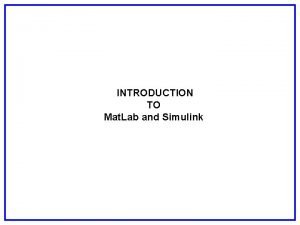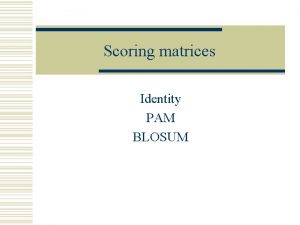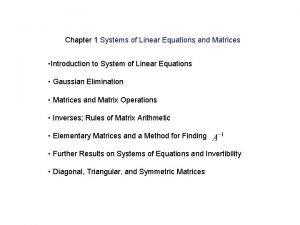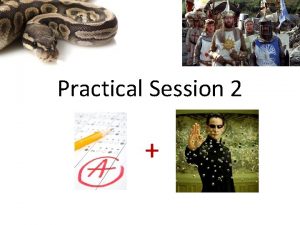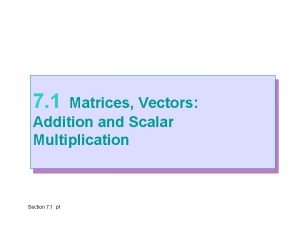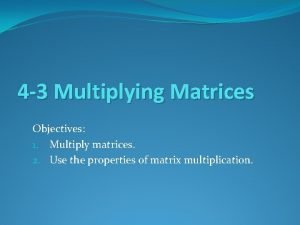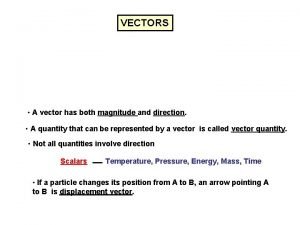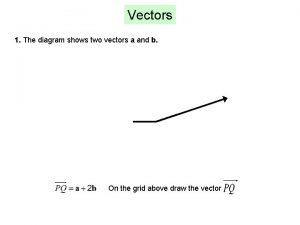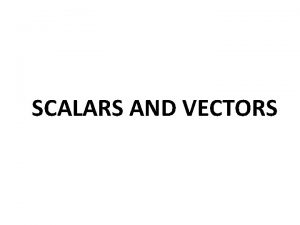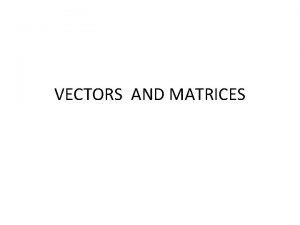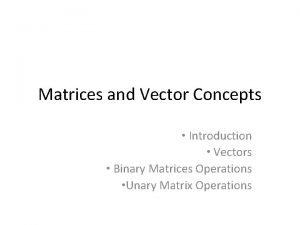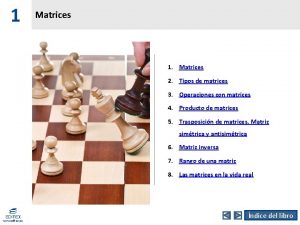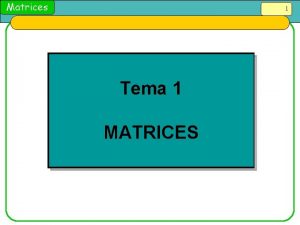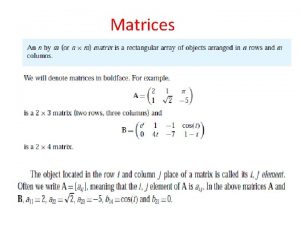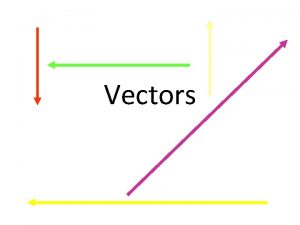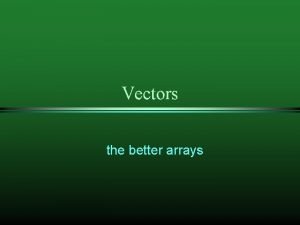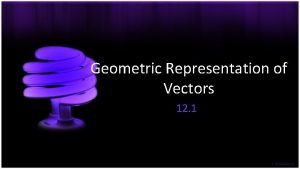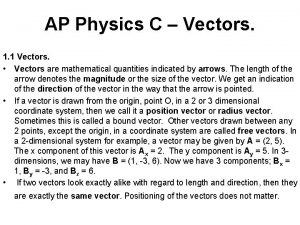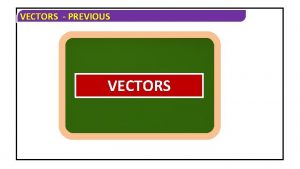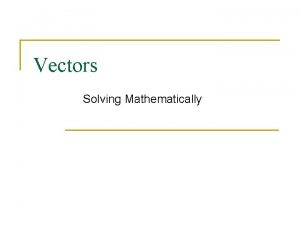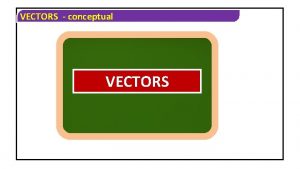Vectors and Matrices Class 17 1 E Ch


















![Cross Product Example: Using your tools. n n TI-89: crossp([1, 5, 7], [2, 4, Cross Product Example: Using your tools. n n TI-89: crossp([1, 5, 7], [2, 4,](https://slidetodoc.com/presentation_image/b15da02598c3151cb4a245b770b1ed3c/image-19.jpg)




![Solving Systems of Equations Using your tools: Using Maple: multiply(inverse([[2, 4, 4], [1, 2, Solving Systems of Equations Using your tools: Using Maple: multiply(inverse([[2, 4, 4], [1, 2,](https://slidetodoc.com/presentation_image/b15da02598c3151cb4a245b770b1ed3c/image-24.jpg)

- Slides: 25

Vectors and Matrices Class 17. 1 E: Ch. 5

Objectives Know what a Cartesian coordinate system is. Know the difference between a scalar and a vector. Review/learn how to interpret, add, subtract, and find the magnitude of vectors n Know how to use the right hand rule.

Objectives Be able to calculate the determinant of a matrix. Be able to calculate the dot and cross products of vectors Be able to represent a system of linear equations as matrices and vectors. Be able to solve systems of linear equations using matrices.

Cartesian Coordinates The Cartesian coordinate system is a system of orthogonal axes which is the basis for describing body and force systems in mechanics. n z n The coordinate system is always right handed (obeys the right hand rule. We will focus on 2 D systems. y x 4

Scalars and Vectors A scalar is a physical quantity having magnitude but not direction n Length, mass, time A vector is a physical quantity having both magnitude and direction n Force, velocity, acceleration 5

Vectors have components along axes of the Cartesian system n x, y, and z axes are denoted by unit vectors w carat often used to imply unit vector w Unit vectors have a magnitude (length) of one. z b a c x y 6

Vectors Consider the 2 D vector magnitude (length) 4 3 2 angle w/ horizontal 1 q 0 -1 -1 0 1 2 3 4 5 -2 7

Dot Product Dot product is a vector operation. n Dot product of matrices does not exist. The result is a scalar. Using tools: n n TI-83, 86: dot TI-89: dotp Maple: dotprod Matlab: dot

Dot Product: Consider the 2 D case: Plot these vectors.

Vector Addition & Subtraction When adding, treat each direction separately 4 To add, place vectors head to tail The negative of a vector is simply pointing in the opposite direction The sum of vectors is called the resultant. 3 2 1 q 0 -1 -1 0 1 2 3 4 5 -2 10

Matrix and Vector A matrix is an n x m array of numbers n n rows, m columns n The ij-th element, aij, is the element in row i and column j A vector is a matrix that has only one row or only one column 11

Basic Functions The transpose is obtained by swapping columns and rows n In Matlab: apostrophe The addition operation requires dimensional agreement. n i. e. to add a m x n matrix and a q x r matrix, must have m = q and n = r Matrix addition is done by corresponding element 12

Matrix Multiplication Matrix multiplication requires innerdimensional agreement n i. e. to multiply a m x n matrix and a q x r matrix, must have n = q Matrix multiplication is done by summing elementwise multiplication of row i in the first matrix with column j of the second matrix to get the ij-th element of the product. 13

Matrix Multiplication 14

Determinant The determinant operation applies to a square matrix (# rows = # columns) n n Denoted with bars 2 x 2 case:

Determinant For the 3 x 3 case: alternate sign

Determinant For higher order cases uses tools. n n TI-86, 89: det Maple: > with(linalg); > det([[1, 5, 7], [2, 4, 8], [3, 6, 9]]); n Matlab: det

Cross Product The cross product is a vector operation n yields a vector according to the right-hand-rule n Also have:
![Cross Product Example Using your tools n n TI89 crossp1 5 7 2 4 Cross Product Example: Using your tools. n n TI-89: crossp([1, 5, 7], [2, 4,](https://slidetodoc.com/presentation_image/b15da02598c3151cb4a245b770b1ed3c/image-19.jpg)
Cross Product Example: Using your tools. n n TI-89: crossp([1, 5, 7], [2, 4, 8]) Maple: > with(linalg); > crossprod([[1, 5, 7], [2, 4, 8]); n Matlab: cross([1 5 7], [2 4 8])

Inverse A matrix times its inverse equals the identity matrix n Identity: All elements on the main diagonal are 1, all others are 0; matrix version of the scalar 1. n Matrix division is undefined Using TI-89: ([[1, 5, 7][2, 4, 8][3, 6, 9]])^-1 Matlab: inv([1, 5, 7; 2, 4, 8; 3, 6, 9]); Using Maple: inverse([[1, 5, 7], [2, 4, 8], [3, 6, 9]]); A-1 =

Linear Equations A linear equation is of the form: where the ai’s are constants (coefficients) In order to solve for n unknowns (xn), n independent equations are needed.

2 Equations, 2 Unknowns Consider the system of equations: 3 things can happen: n n n Exactly one solution (lines intersect) independent No solution (lines are parallel) Infinite number of solutions (same line)

Solving Systems of Equations Consider a system of 3 eqns, 3 unknowns: This can be written as: x= Using inverses can only be used if there is a single, unique solution; If multiple or no solutions exist, the inverse does not exist
![Solving Systems of Equations Using your tools Using Maple multiplyinverse2 4 4 1 2 Solving Systems of Equations Using your tools: Using Maple: multiply(inverse([[2, 4, 4], [1, 2,](https://slidetodoc.com/presentation_image/b15da02598c3151cb4a245b770b1ed3c/image-24.jpg)
Solving Systems of Equations Using your tools: Using Maple: multiply(inverse([[2, 4, 4], [1, 2, 1], [3, 4, 2]]), [[12], [4], [1]]); Using TI-89 (([[1, 5, 7], [2, 4, 8], [3, 6, 9]])^-1)*([12; 4; 1]) Or use ‘solve’ Using Matlab: inv ([2, 4, 4; 1, 2, 1; 3, 4, -2])*[12; 4; 1]);

Homework Web. Assign Your documentation of your homework is 20% of your webassignment grade. Homework documentation is due at the beginning of class when the webassign homework is due. If webassign is not due at the beginning of a class, your documentation is due at the beginning of the immediate next class or lab. If you need a refresher on problem presentation, read Ch. 2 in Eide
 Vectors and matrices
Vectors and matrices The multimodal text big ed mona
The multimodal text big ed mona Ivory no 1 retainer parts
Ivory no 1 retainer parts Aims and objectives of matrices
Aims and objectives of matrices Applications of matrices and determinants
Applications of matrices and determinants Pam scoring
Pam scoring Chapter 1 systems of linear equations and matrices
Chapter 1 systems of linear equations and matrices Node reduction algorithm in software testing
Node reduction algorithm in software testing Amino acid substitution matrix
Amino acid substitution matrix Identity matrix
Identity matrix Transpose of matrix product
Transpose of matrix product Determine whether each matrix product is defined
Determine whether each matrix product is defined Matrices formula
Matrices formula Difference between abstract class and concrete class
Difference between abstract class and concrete class Difference between abstract class and concrete class
Difference between abstract class and concrete class 7 rights of medication administration in order
7 rights of medication administration in order Static vs dynamic class loading in java
Static vs dynamic class loading in java Unit vector
Unit vector Vectors and scalars in physics
Vectors and scalars in physics Tan-1(ry/rx)
Tan-1(ry/rx) Components of vectors
Components of vectors A vector has both magnitude and direction
A vector has both magnitude and direction The diagram shows two vectors that point west and north.
The diagram shows two vectors that point west and north. Sin 37°
Sin 37° Scalar and vector quantities
Scalar and vector quantities Scalars and vectors
Scalars and vectors
